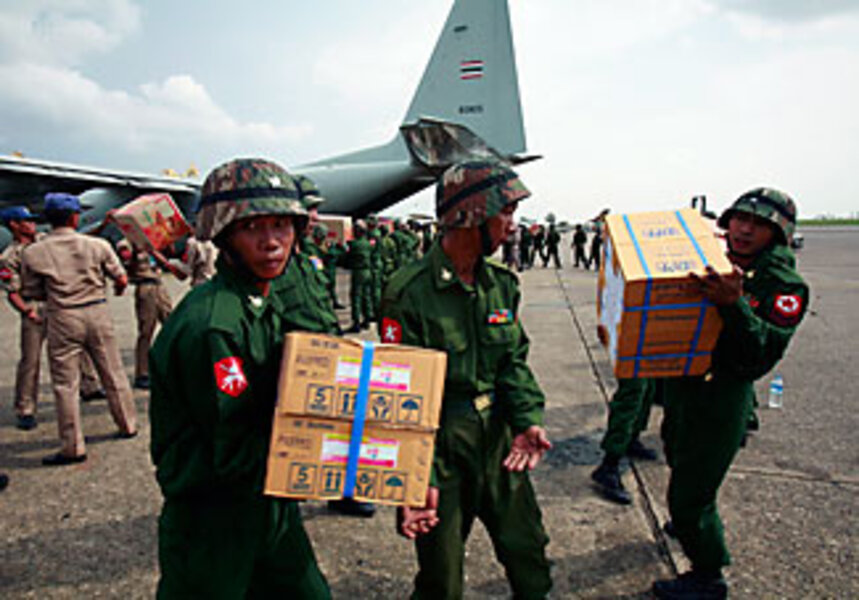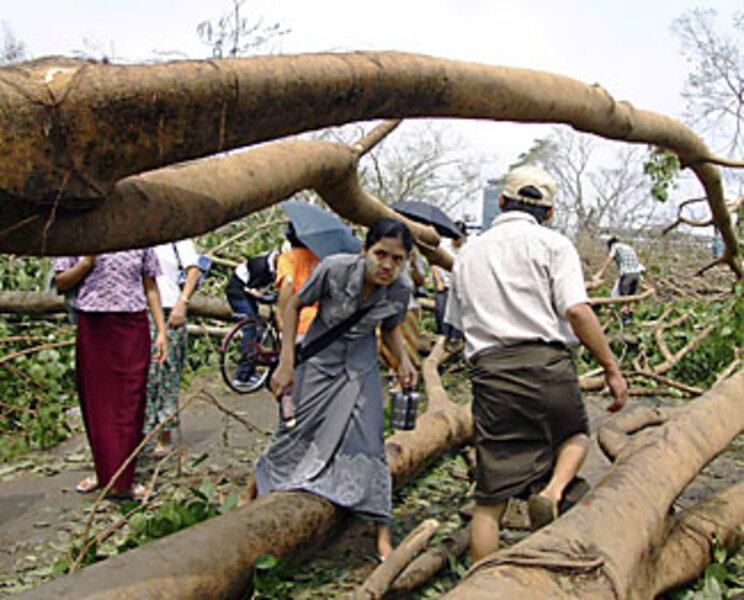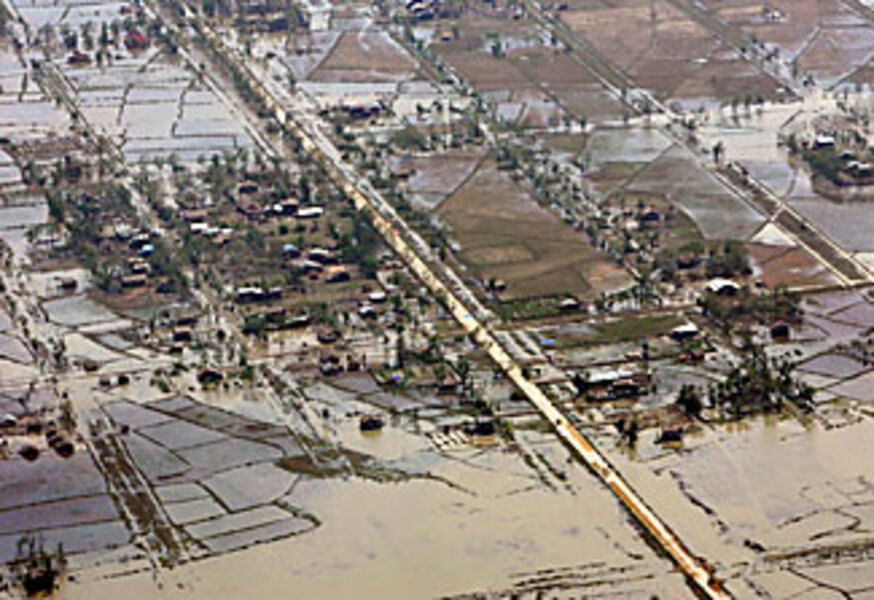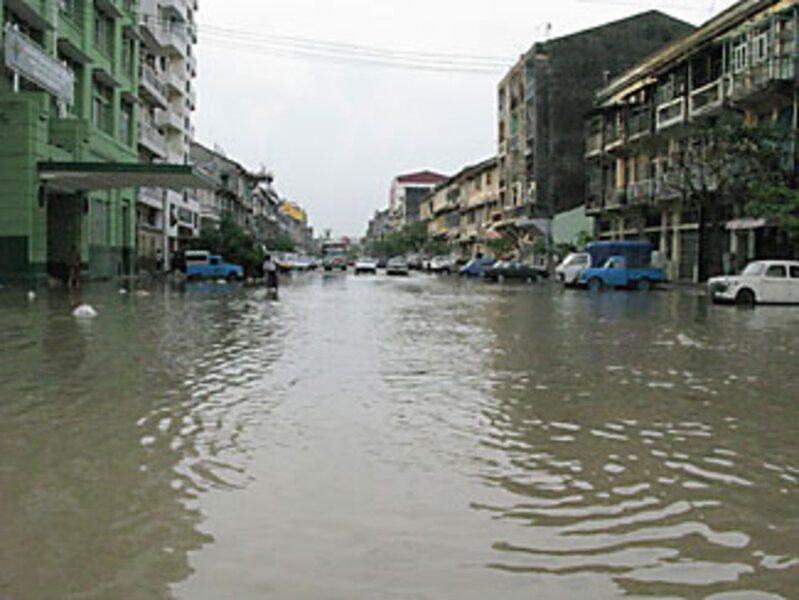Will Burma (Myanmar) let world in for aid?
| Phnom Penh, Cambodia
The military government in Burma (Myanmar) is receiving an outpouring of emergency aid offers from the international community, as the death toll from Saturday's cyclone continues to soar. While some foreign aid workers were told they could enter the country to assess needs and distribute supplies, as of Tuesday – three days after the disaster hit – they were still awaiting visas. The delay raises questions as to how willing the hermit regime is to facilitate relief in the crucial, early stages of this humanitarian emergency.
"We don't know the extent of the damage. We're having trouble contacting our people," says Chris Lom, a spokesman for the UN International Organization on Migration (IOM) in Thailand.
Meanwhile, the regime faced mounting criticism for its alleged neglect in preparing for the disaster. With Burma's tightly controlled state media offering scant details, it was unclear how the government was directing its emergency response.
But the Burmese Army, which mobilized quickly and harshly to suppress democratic protests last September, has been described as slow to offer assistance now by some observers, while state authorities are accused of failing to provide shelter information despite knowing that cyclone Nargis would set down Saturday with destructive force.
"The regime has lost a golden opportunity to send the soldiers as soon as the storm stopped to win the heart and soul of people," a retired civil servant told Reuters. "But where are the soldiers and police? They were very quick and aggressive when there were protests in the streets last year," he said.
State officials confirmed on Tuesday night that 22,000 people were killed by the cyclone, with 41,000 missing, a drastic increase that made the disaster the worst to hit Asia since the 2004 tsunami, which left some 230,000 people dead.
Other reports suggested that Saturday's death toll would rise significantly. Already, it has escalated quickly: from 351 on Saturday, to 4,000 on Monday morning, to 10,000 that night. By Tuesday morning, state-run television stated that 10,000 people alone had been killed in the town of Bogalay.
Speaking from a phone on the Thai-Burmese border Tuesday, Nyo Myint, of the National League for Democracy party led by Nobel laureate Aung San Suu Kyi, says the death toll, calculated by reports from party sources across southern Burma, is more than 100,000.
International relief agencies reported that, with phone and Internet lines down and roads washed away, merely assessing the damage would be difficult at best, let alone dispensing aid.
"The major challenge is to figure out an exact assessment of the damage," says Jennifer Pagonis, a spokesperson for the United Nations High Commissioner for Refugees in Geneva.
The disaster is compelling one of the world's most secretive and isolated regimes to swing open its doors to the international community. At a meeting with foreign diplomats on Monday, Burma's foreign minister Nyan Win appealed for international aid – a dramatic political reversal from 2004, when the junta rejected such assistance after the devastating tsunami.
At least one planeload containing nine tons of relief supplies was reported to have landed in Rangoon, the former capital, Tuesday, flown in by the Thai military. Thailand also said it would make available $100,000 in emergency funds, the Bangkok Post reported.
But as of Tuesday, international relief groups were still awaiting final confirmation from Burma's government that their workers and supplies would be allowed in.
"[International relief groups] don't yet have clarification. Insofar as the Myanmar authorities are interested in getting aid, we will of course facilitate international relief workers, although it's not clear how many," says Mr. Lom.
A worsening portrait of ruin has emerged in the wake of the cyclone, which ripped through Burma's central coast on Saturday, packing 120 mile-per-hour winds that flattened shantytowns and 12-foot tidal waves that swept away entire villages in low-lying coastal areas. Eight townships were reported as completely destroyed.
Even before the cyclone hit, the Irrawaddy River delta southwest of Rangoon was known as a swampy landscape of poor farmers and fishermen with flimsy homes. The area, one of the least developed in southeast Asia, lacks dykes or other barriers to protect people from sea surges.
Mr. Myint, of the NLD, said he spoke by satellite phone with another party member who went to the devastated Irrawaddy delta area to search for family members.
"The worst thing is in the villages. Only two or three survivors in each village, with maybe 1,000 population in each," says Myint. "He saw hundreds of dead bodies in Bogalay yesterday, lying on the road. Nobody is collecting them. It looked like they drowned in the sea surge."
Myint's colleague moved on to nearby Lattputa Tuesday, where he reported that at least half of the township's population of 40,000 was dead. "Most of the people are helpless. They have no food, water, or medicine," Myint continued.
Survivors, meanwhile, entered their fourth day without electricity and drinking water in many areas, including Rangoon, home to 6.5 million people. Threats of disease remain high, relief agencies warn, and hundreds of thousands are said to be homeless.
Aside from issuing appeals, the government's response to the disaster has been difficult to gauge, given broken communication lines. Some news reports suggested that it was slow and inadequate, with very few soldiers dispersed to provide relief. Such a poor showing, if true, would contrast sharply with the Army's quick outpouring against demonstrations.
As the storm swelled on Friday night, state television broadcast warnings of tidal waves and heavy winds, but provided no further instructions for seeking shelter, the Associated Press reported.
First lady Laura Bush, a leading international critic of Burma's military regime, which has ruled since 1962, was among the most outspoken critics of the Army-backed government's response. "Although they were aware of the threat, Burma's state-run media failed to issue a timely warning to citizens in the storm's path," Mrs. Bush said at a press conference on Monday.
President Bush urged Burma to allow US damage assessment teams into the country while at a ceremony Tuesday, where he signed legislation to give a Congressional Gold Medal to Ms. Suu Kyi, who is under house arrest in Burma.
While that honor is unlikely to win favor from Burma's government, emergency assistance sometimes helps improve ties between unfriendly states.
"[Disaster diplomacy] can have an enormous impact. This is a way to open up relations with countries you don't have good relations with. It's a way to present good will and good intentions," says Charles Perry, executive vice president of the Institute for Foreign Policy Analysis, a research organization in Cambridge, Mass.
But he cautions that diplomacy only builds dividends in the long run, if humanitarian aid programs are sustained for a matter of years, not months.
The situation in Burma is an opportunity for the US, if it commits to a longer term course of relief and dialogue, he says, adding, "It's an opportunity for the generals to open up as well."
But government officials in Burma have invited further criticism by refusing to call off a controversial referendum on a new constitution originally scheduled for May 10. Instead they announced on Tuesday that it would be postponed until May 24 in 47 townships hard hit by the disaster. Critics, who have already blasted the referendum as a sham designed to solidify the military's rule, say the government should focus on relief instead.
Despite growing critiques, the international community and neighboring countries moved quickly to offer support to victims (see below). With aid lining up, relief agencies said they are confident the ruling government will give the final green light to international aid, but hoped it would come soon.
"The sooner the better," says Lom.
• Christopher Johnson contributed from Tokyo.









